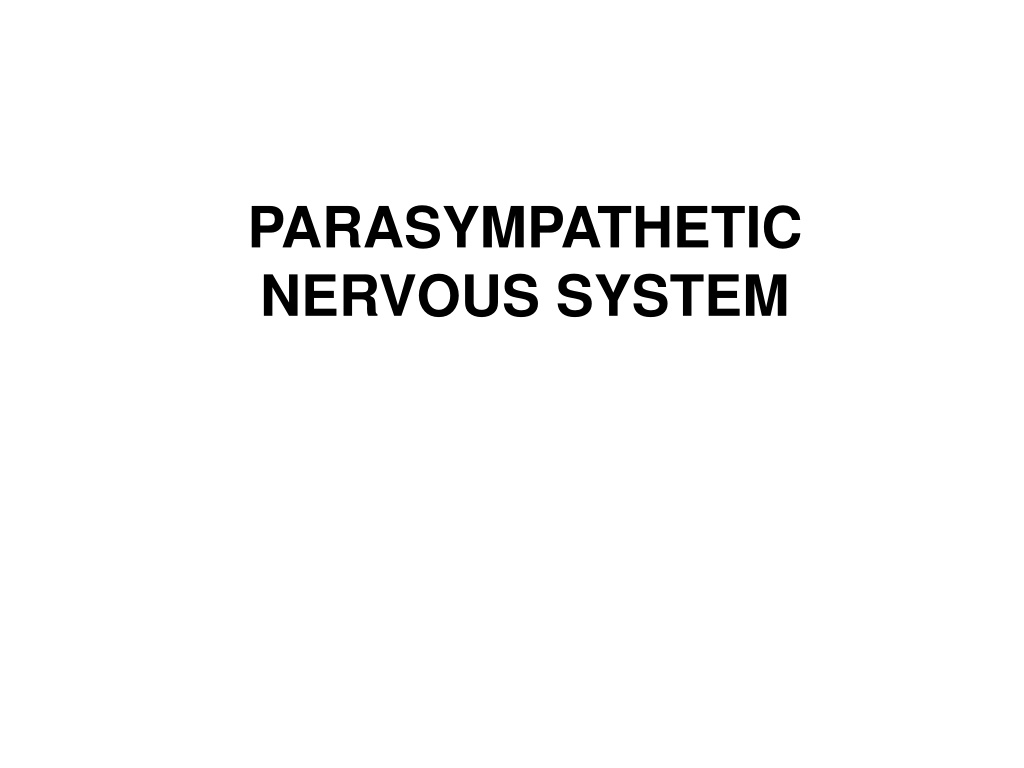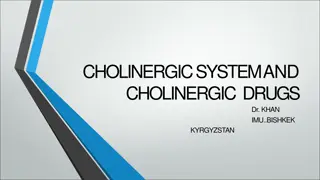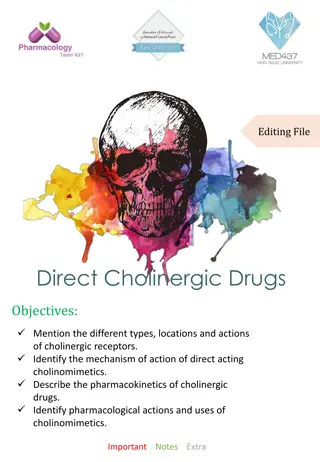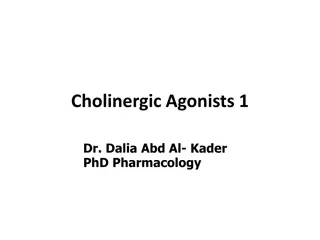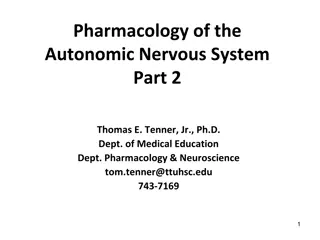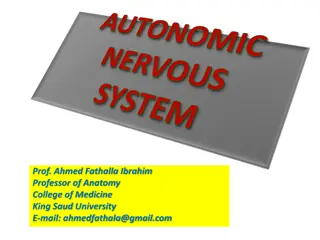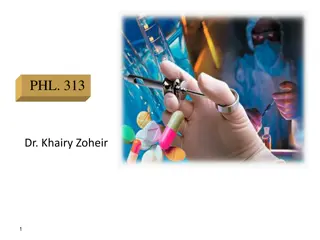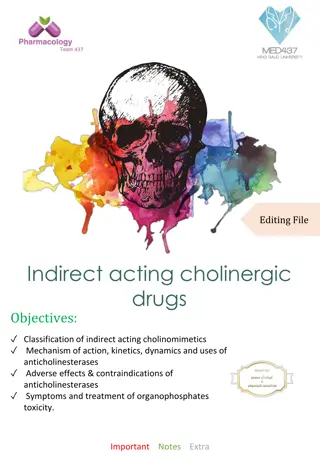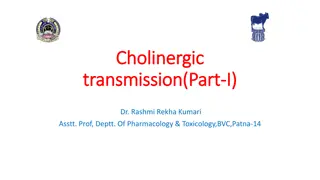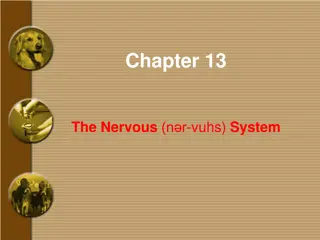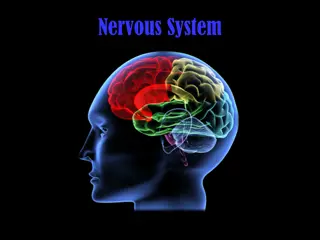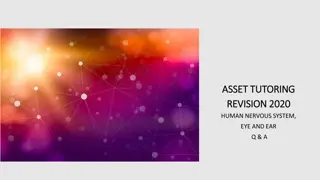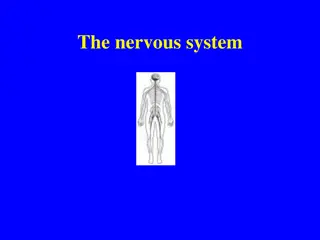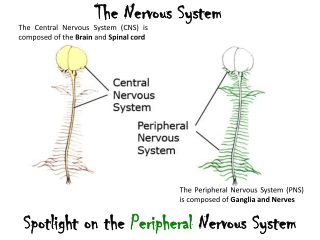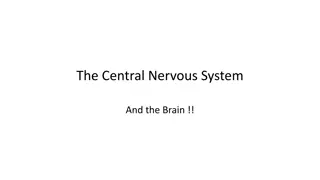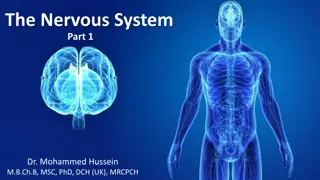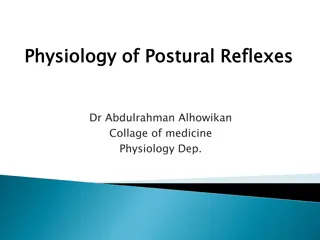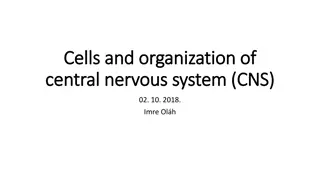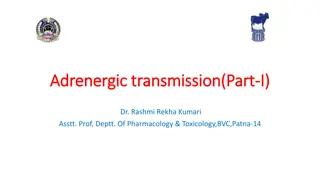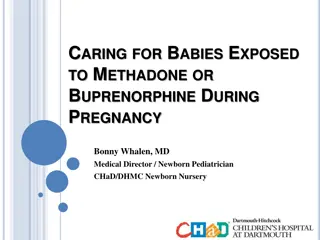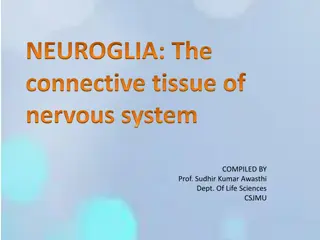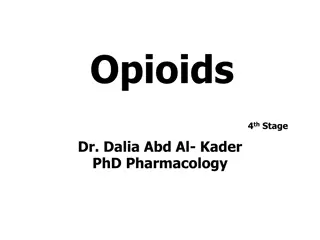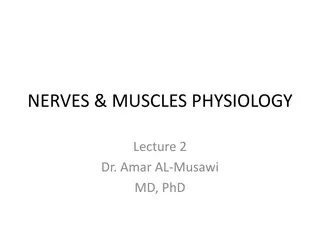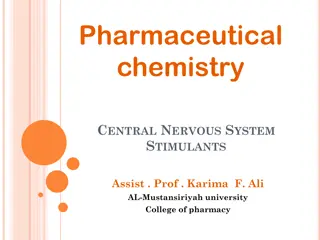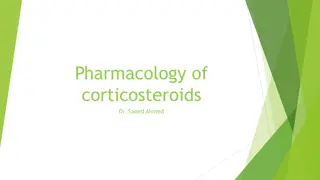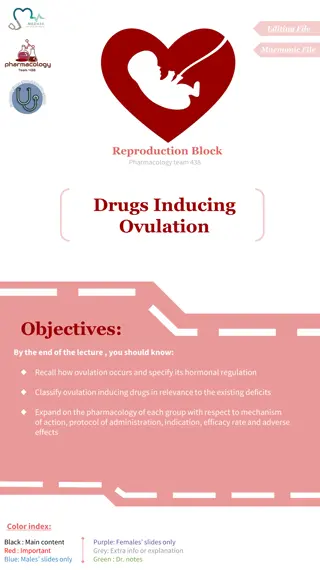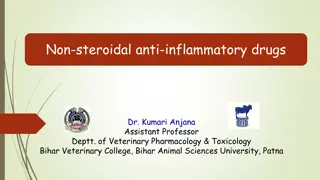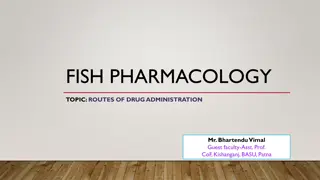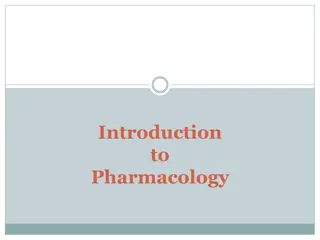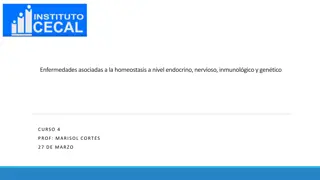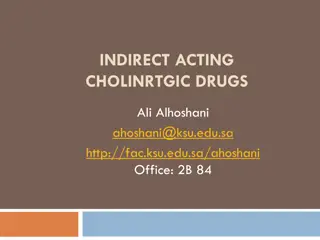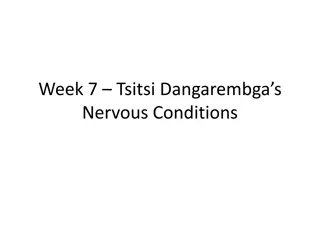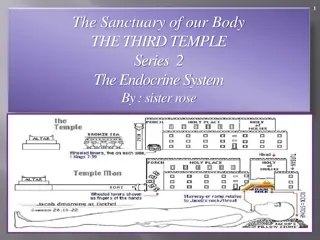Understanding the Parasympathetic Nervous System and Cholinergic Pharmacology
Dive into the world of the parasympathetic nervous system and cholinergic pharmacology, exploring concepts like cholinomimetics, parasympathomimetics, cholinolytics, and more. Discover how acetylcholine synthesis and degradation play crucial roles in these processes, and learn about different cholinotropic agents based on their chemical structures.
- Parasympathetic Nervous System
- Cholinergic Pharmacology
- Acetylcholine Synthesis
- Cholinomimetics
- Pharmacological Interventions
Download Presentation

Please find below an Image/Link to download the presentation.
The content on the website is provided AS IS for your information and personal use only. It may not be sold, licensed, or shared on other websites without obtaining consent from the author. Download presentation by click this link. If you encounter any issues during the download, it is possible that the publisher has removed the file from their server.
E N D
Presentation Transcript
PARASYMPATHETIC NERVOUS SYSTEM
Cholinergic drugs elicit their effect: 1) via the parasympathetic synapses of effector organs 2) via synapses of the autonomic nerve ganglia 3) via synapses of neuromuscular junctions 4) via synapses in CNS - influence synapses, where acetylcholine (ACh) acts as their neurotransmitter
Cholinergic nervous system - pharmacological interventions acetylcholine analog. cholinotropics cholinomimetics cholinolytics ACHE inhibitors direct indirect indirect direct NN M NN M ganglioplegics parasympatholytics parasympathomimetics gangliomimetics NM muscle relaxants
Terminology: Cholinomimetics - activity at cholinergic synapses direct ACh and its analogues they imitate ACh effects on M and N receptors indirect - ACHE inhibitors always non-selective short-term effect - edrophonium intermediate and long-term effect - carbamates ( stigmins ) very long effect - organophosphates Parasympathomimetics - they imitate ACh effect on M rc. direct (mostly non-selective effect) stimulatory agents selective to M receptors for ACh
Terminology: Cholinolytics - direct: - agents blocking acetylcholine receptors Parasympatholytics - M receptor blockers - without any effect on nicotinic receptors Ganglioplegics - NN-receptor blockers Peripheral muscle relaxants (non-depolarizing) - NM-receptor blockers - indirect: e.g. presynaptic inhibition of ACh release
Acetylcholine synthesis choline in a lecithin form is a dietary supplement lecithin acts as a precursor to ACh + acetyl CoA choline choline acetyltransferase (CHAT) acetylcholine (ACh)
Acetylcholine degradation hydrolysis acetylcholinesterase (ACHE) acetylcholine + choline acetate
Cholinotropic agents - according to the chemical structure we distinguish: agents with quaternary ammonium cation quaternary amines, e.g. muscarine with low GIT absorption (they do not cross BBB) tertiary amines, e.g. natural alkaloids (nicotine, physostigmine)
Cholinomimetics - cholinergic agonists - pharmacological effects: CVS - negative chronotropic effect - heart depression - generalized vasodilation GIT - increased motility of smooth muscles respiratory tract - bronchoconstriction bronchial secretion eye - miosis, intraocular pressure lacrimation sweating, salivation CNS - tremor, increased locomotion
Acetylcholine and its analogues acetylcholine rapid biodegradation by ACHE not used in clinics 5-20 s effect after i.v. administration limited absorption after oral / s.c. administration does not penetrate BBB - other choline esters: carbachol poor absorption from GIT agonist of M and N Rc not hydrolyzed by cholinesterase long duration of action I: ophthalmology - miosis cevimeline selective M agonist - parasympathomimetic I: xerostomia (dry mouth), Sj gren s syndrome
Acetylcholine and its analogues postganglionic neuronal activity neuromuscular signal transduction activity of parasympathetic effectors sympathetic stimulation of sweat glands - pharmacological effects: BP, bradycardia, danger of heart arrest nauzea, cough, dyspnoe vascular dilation: NO release salivation, lacrimation, mucosal gland secretion excessive sweating
Cholinomimetics - natural alkaloids pilocarpine (Pilocarpus) non-selective M receptor agonist good absorption from GIT BBB crossing ( CNS excitation) stimulates gland secretion stimulates m. sphincter pupilae (eyedrops) I: miotic agent used in ophthalmology 2-4%, Sj gren's syndrome muscarine (Inocybe, Clitocybe, Amanita muscaria/phalloides) M receptor agonist, quaternary amine arecoline (Areca catechu) CNS stimulant, tertiary amine M and N receptor agonist
Indirect cholinomimetics ACHE inhibitors long-term (IRREVERSIBLE) short-term (REVERSIBLE) competitive enzyme inhibition complex inhibitor + enzyme COVALENT INHIBITION toxicology medicinal use
Indirect cholinomimetic agents Reversible ACHE inhibitors General indications: glaucoma GIT atony urinary retention antidotes of non-depolarizing muscle relaxants myasthenia gravis (use quaternary amines) Alzheimer s disease (use tertiary amines) intoxication with organophosphates poisoning associated with the central anticholinergic syndrome (atropine)
Indirect cholinomimetic agents Reversible ACHE inhibitors Side effects: miosis increased glandular secretion nausea, diarrhea heart depressants (negative chronotropic effect) CNS stimulation followed by depression neuromuscular junction - fasciculation and twitching (overdose - depolarization blockade) overdosing = cholinergic crisis depolarization blockade - muscle paralysis
Indirect cholinomimetics Reversible ACHE inhibitors neostigmine, (edrophonium) short-term effect I: diagnosis of myasthenia gravis decurarization , antidotes of competitive muscle relaxants pyridostigmine, ambenonium longer effect than neostigmine, slower onset of action weaker muscarinic effect - less GIT side effects I: myasthenia gravis distigmine long-acting reversible ACHE inhibitor I: myasthenia gravis, atonic the urinary bladder, uterine atony, postoperative GIT atony, paralytic ileus
Indirect cholinomimetics Reversible ACHE inhibitors - CNS effects of drugs, that can cross the blood-brain barrier physostigmine I: antidote in acute intoxications with central anticholinergic syndrome galantamine, rivastigmine, donepezil I: dementias of the Alzheimer s type galantamine has a positive allosteric effect on ACh binding on N rec.
Indirect cholinomimetics Irreversible ACHE inhibitors - effects: nausea, vomitus, sweating, CVS collapse, breath depression, fasciculation and twitching muscle paralysis, CNS convulsions - agents: organophosphates insecticides (malathion, parathion) chemical weapons such as nerve gas sarin or VX, soman, tabun - their antidotes: obidoxime, trimedoxime, pralidoxime
Indirect cholinomimetics Irreversible ACHE inhibitors Therapy of organophosphate itoxication: 1. reduce further neurotoxine absorption 2. mechanical ventilation 3. atropine i.v. in high doses 2 mg every 5 min until a slight overdose (in mass-casualty settings s.c.) 4. ACHE reactivators : obidoxime, (pralidoxime) 5. therapy of muscle convulsions i.v. benzodiazepines 6. high doses of reversible ACHE inhibitors 7. bioscavengers
Parasympatholytics tertiary amines blockade of M receptors quaternary amines blockade ofM >N receptors atropine scopolamine tropicamide, cyklopentolate oxybutynine tolterodine, fesoterodine solifenacin, darifenacin procyklidine, biperiden (pirenzepine, telenzepine) (homatropine) butylscopolamine phenpiverine, propiverine otilonium, glycopyrrolate ipratropium, tiotropium aclidinium, umeclidinium trospium (oxyfenonium),(poldin)
Parasympatholytics direct antimuscarinic agents General indications: spasmolytics bronchodilating agents antiarrhythmics mydriatics premedication prior to GA antiemetics antiparkinson agents antidotes of pilocarpine, ACHEI poisoning (physostigmine)
Parasympatholytics direct antimuscarinic agents Side effects: dry mouth (xerostomia) dry eyes (xerophthalmia) loss of accommodation (cycloplegia) heart palpitations constipation urinary retention CNS: seizures, severe dyskinesias, hallucinations, agitated delirium, respiratory depression, coma
PL with tertiary N atropine, tropicamide, cyclopentolate, homatropine mydriasis (stimulation of m. sphincter pupilae) cycloplegia (paralysis of the ciliary muscle of the eye) I: for diagnostic and therapeutic mydriasis scopolamine (hyoscine) TTS, supp. I: therapy of kinetosis, CNS depression oxybutinine orally, TTS pharmacokinetics: high 1stpass effect I: antispasmodic agent used for overactive urine bladder
PL with tertiary N Selective parasympatholytics: darinefacin, solifenacin M3uroselective antagonists I: symptomatic therapy of overactive urinary bladder (pirenzepine) gastric M1 receptor selective antagonist former indication: gastroduodenal ulcers
PL with quaternary N - do not cross BBB (blood-brain barrier) spasmolytics for functional bowel disorders: otilonium N-butylscopolamine phenpiverine (oxyphenonium),(poldin) urinary antispasmodic for hyperactive urinary bladder: trospium ipratropium (SAMA) tiotropium, aclidinium glycopyrrolate, umeclidinium bronchodilator agents: (LAMA) * long acting muscarinic antagonists (LAMA) short acting muscarinic antagonists (SAMA)
Skeletal muscle relaxants 1. Centraly acting 2. Peripheral effect on neuromuscular junctions nondepolarizing - NMantagonists - antag. by ACHEI - tubocurarine - mivacurium - atracurium, cisatracurium - rocuronium, pipecuronium - (pancuronium, vecuronium) depolarizing - NMagonists - decamethonium - suxamethonium indirect muscle relaxants: dantrolene, botulinum toxin
